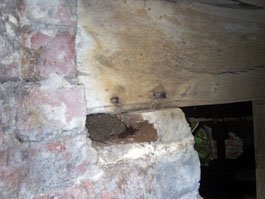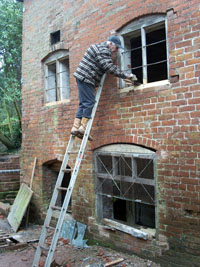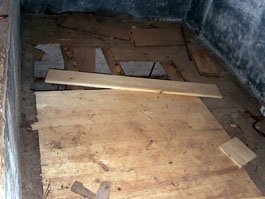Best viewed in landscape
Watermill Blog - More Decay
7th February 2008
Yet again this watermill blog has to report finding yet more decay. Sometimes it seems that we cannot turn over a single piece of timber without finding rot or woodworm on the hidden side.

The latest find is the pad under one end the large beam that support the stone platform.
It came to light when we removed the large window frame from the ground floor of the mill for repair and we will have to deal with this quickly.
The beam is older than the brick structure and the pegs visible in the picture probably secured a post that has been replaced by the brick pier. We need to support the beam, remove the rotten wooden pad and insert a replacement.
The wooden pad seems to have been softwood as far as we can tell so no real problem there but supporting the beam will need some strong props!
The team today consisted of Colin, John, Richard, Headley, Dave, Max, Jonathan and Dick. Dick has started the re-assembly of the chaff cutter after he and Headley cleared a space for it in the corner of the stable.
Colin and Dave worked inside the mill, planning the work needed to repair the upstream side of the hurst. The timbers from here are another example of how hidden decay can come to light. An oak post that looked mostly sound at first sight turned out to be a hollow shell for most of its length.
These timbers are the oldest part of the mill and we have to take great care to maintain the historical integrity of the watermill as well as ensuring the structural integrity. We are seeking expert advice.

John and Jonathan used their time working on windows. John completed the bricking in of one window while Jonathan worked on the one below.
This lower window doesn't seem to be original to the mill but is repairable so that is what we are going to do.
At the moment it does not have a sill rail, so we will make a new one. The lower section was slatted and all the sockets for the slats are sound so the new sill rail will have matching sockets so that we can have slats instead of wire mesh.
Richard's comment when he realised how much work that involved was not printable. He seems to have become the joiner for the team, in much the same way that John became the bricklayer.
Apart from assessing the work needed to make a slatted window, he made a new half for the sack hoist hatch in the garner floor. Max has been working on the floor repair up there for a while now and is making progress.

He is determined to leave the walls of the grain bins in place and has taken to removing some of the rotten floorboards from below, working up a stepladder.
The picture shows some of the new boards and you can just make out how they fit under the metal lining of the bin on the left of the shot.
The right hand side of the bin in the picture is the outside wall of the mill and the planking there was repaired at some time in the past. Max is matching the random widths of the boards he is replacing but the old repair made no attempt to do the same.
That's about it for this watermill blog entry. We had all left for home before five o'clock.
Go to the next entry by clicking here.
Go to the previous Watermill Blog entry
Learn how to Support Us
Return to our Home Page